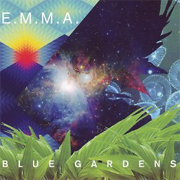I’ve always been fond of the notion that music, to some extent, reflects its surroundings. In the past, commentators on grime have drawn parallels between its vertically packed, claustrophobic rhythmic clatter and its East London tower block origins – something Dan Hancox explores further in his thoroughly recommended new e-book Stand Up Tall: Dizzee Rascal & The Birth Of Grime, while discussing the impact upon Bow-based early grime artists of growing up beneath Canary Wharf’s ever-watchful gaze, and asking how that visual influence might have inspired the genre’s futuristic melodic architectures. So, then, where on earth does the knackered grime of E.m.m.a call home: its melancholic, sing-song melody lines, its bob-and-weave UK funky rhythms, its overly sugary synth fizz spun like candyfloss across barebones percussion?
E.m.m.a is currently London based and part of Keysound’s collective of producers gathered together on this year’s great This Is How We Roll compilation, but if anything her debut album Blue Gardens postulates how grime might have sounded had its key protagonists instead grown up next to a decrepit old South Coast seaside town promenade. The bounding sub pulses and 3/4 time signature of ‘Dream Phone VIP’ travel along wild, off-kilter undulations, like a waltzer gone feral. ‘Shoot The Curl’s pinball drums ricochet around the mix while melody lines light up like LEDs in whizzing arcs. ‘Outro’ makes its geographical location explicit: a seafront field recording, with an accordion player’s lonely strains caught up in blustery wind, thunder and the incessant, inane chatter of herring gulls.
There are clear connections between E.m.m.a’s music and early work from Ikonika, Darkstar and Zomby, who lashed similarly fluorescent synth matter to wonky rhythmic structures. The latter’s 2009 extended EP One Foot Ahead Of The Other springs to mind in particular: like E.m.m.a’s ‘Cherry Favour’, it conjured up images of Hallowe’en fairground abandon and scary-looking youths in skull masks puffing on badly rolled spliffs and munching low-grade LSD in the underbelly of the ghost train. Which, I suppose, could make Blue Gardens seem slightly anachronistic – weren’t people doing this sort of thing with equally creepy flair six years ago?
Well, yes, but not quite like this. Despite its overall lighthearted, ebullient mood, E.m.m.a’s music is almost unsettlingly weird at times, and laugh-out-loud bizarre at others – a cameo from Congo Natty on ‘Jahovia’ seems hilariously incongruous the first time you hear it (it settles in over time). But beneath the surface pulse darker and more ambiguous images, of decaying grandeur and shadowy streets, of fruitlessly pouring money into 10p pushing machines, of sitting on the sea wall at twilight as a teenager, smoking and staring across the pebbles while carnival organs grind merrily away a few hundred metres down the beach. (Tellingly, these atmospheres mirror those of early eski instrumentals, which evoked sensations of sitting around tense but bored, simultaneously desiring and dreading some action, except situated in a gloomy London estate rather than with the salty tang of sea air catching in your hair).
She’s also possessed of a remarkable skill with melody and harmony: Blue Gardens snags the listener with hook after hook after lopsided hook. It helps that I’m of the right age to remember some of the influences she cites, in particular the Encarta theme music (a PC encyclopedia software from well before the age of Wikipedia, for those unfamiliar), and its overall 8-bit, videogame melodic sensibility carries undeniable nostalgic weight. But even beyond those reminiscences, the clunky and slightly Fisher Price feel of her synth textures seems conceived almost as a ruse to disguise – or, seemingly counterintuitively, even highlight – the dazzling harmonic configurations they fall into along the way. Sanding all their edges rough and jagged, like the bits of ruined pier jutting out of the sea off Brighton beach, serves to make those rare moments when everything falls briefly into perfect consonance – the lovely, rippling arpeggios that usher in ‘Cherry Favour’s second half, for example – all the more moving.


